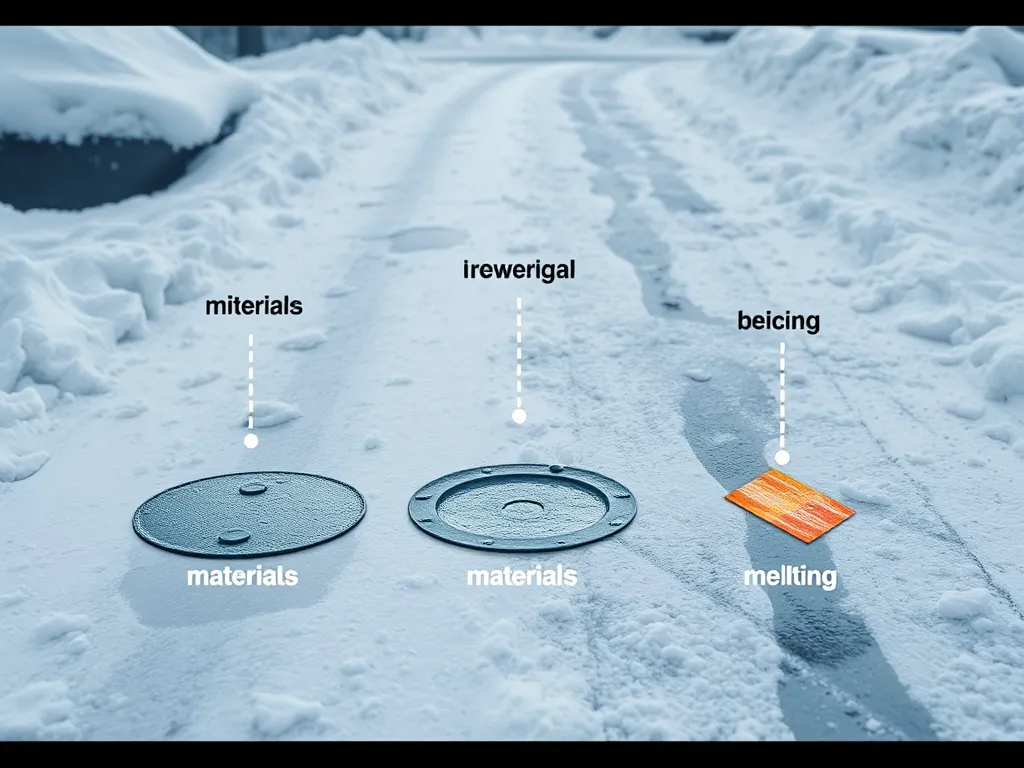Deicing Strategies for Asphalt Roads: Methods, Equipment, and Best Practices
Published on: November 11, 2025 | Last Updated: April 14, 2025
Written By: George Voss
Deicing strategies for asphalt roads combine mechanical removal, chemical treatments, and eco-friendly alternatives to combat ice buildup while protecting pavement. Unlike basic snow plowing, these methods target ice prevention and removal at temperatures ranging from -25°F to 32°F. Effective approaches balance safety with environmental care, using tools like brine solutions, blade plows, and beet juice derivatives that reduce chloride use by 30%.
This article breaks down ice-fighting techniques for asphalt surfaces. Learn how temperature affects ice adhesion, compare salt-based treatments with agricultural byproducts, and explore heated pavement systems. Get equipment insights for precise brine spraying and plow operations, plus data-driven methods to cut maintenance costs by 15-40%.
Contents
- Understanding Ice Formation on Asphalt Roads
- Mechanical Deicing Strategies for Asphalt Roads
- Chemical Deicing Methods for Asphalt Pavements
- Alternative Deicing Strategies for Asphalt
- Chemical Deicing Methods for Asphalt Pavements
- Alternative Deicing Strategies for Asphalt
- Environmental Considerations for Asphalt Deicing
- Best Practices for Pavement Road Deicing
- Specialized Asphalt Deicing Equipment
- Frequently Asked Questions About Asphalt Deicing
- Closing Thoughts
- Useful References for You:
Understanding Ice Formation on Asphalt Roads
Ice grips asphalt roads through complex bonds. These bonds form due to road texture, mix design, and weather shifts. Knowing this helps pick the best ways to deice asphalt roads.
How Ice Adheres to Asphalt Surfaces
Asphalt’s rough face traps water in tiny pores. When temps drop, this water freezes, locking ice to the road. The black top soaks up sun heat by day but loses it fast at night. This speeds ice growth in cracks and grooves. Bitumen (asphalt binder) also reacts with ice, making bonds harder to break. Salt or plows must disrupt these bonds to clear roads.
Impact Of Temp Shifts on Asphalt Pavement
Asphalt swells in heat and shrinks in cold. These shifts create cracks that let water seep in. When water freezes, it widens cracks, raising repair costs by 15-30%. Temp swings also affect deicing plans. Salt works best above 15°F but fails in bitter cold. Roads need different deicing techniques asphalt teams can adjust as temps change.
These ice-road bonds and temp shifts shape how crews pick tools to clear roads. Next, we break down the gear and steps that tackle winter’s grip on asphalt.
Mechanical Deicing Strategies for Asphalt Roads
Physical ice removal keeps asphalt surfaces clear while reducing chemical use. These methods work best when paired with smart timing and proper gear.
Plowing and Snow Removal Equipment
Snow plows form the first line of defense against ice buildup. Modern gear protects pavement while boosting efficiency.
Blade Plows for Asphalt-Safe Ice Removal
Polyurethane-edged blades scrape ice without gouging asphalt. Operators angle blades at 30-45 degrees to clear 90% of snow in one pass. Replace steel edges to prevent surface damage.
Specialized Asphalt Snow Removal Machinery
Infrared melters target ice patches at 300°F. Snow melters process 500 tons/hour, slashing stockpile needs. Tracked vehicles with rubber treads prevent asphalt wear.
Thermal Deicing Techniques
Heat-based systems stop ice before it bonds to pavement. These high-tech options work well on bridges and steep grades.
Heated Pavement Systems for Asphalt Roads
Hydronic pipes under asphalt circulate glycol at 120°F. Electric coils use 30-50 watts/sq.ft. to maintain 35°F surfaces. Costs range $12-$30/sq.ft. for install.

Chemical Deicing Methods for Asphalt Pavements
Deicers lower water’s freezing point to break ice bonds. Choose chemicals based on temp, cost, and pavement needs.
Common Road Deicing Chemicals
Three chlorides dominate winter road care. Each works at different temps and has unique effects on asphalt.
Sodium Chloride (Rock Salt) on Asphalt
Salt melts ice down to 15°F but speeds asphalt aging. Use 250 lbs/lane mile max. Rinse surfaces in spring to prevent pitting.
Calcium Chloride Applications
Works to -25°F with less material (150 lbs/lane mile). Draws moisture – pre-wet roads to avoid sticky residues.
Magnesium Chloride Treatments
Effective to -13°F with 30% less chloride runoff. Costs 15% more than salt but protects asphalt longer.
Liquid Anti-icing Agents
Liquid treatments prevent ice bonds better than granular apps. Apply 30 gal/lane mile for 48-hour protection.
Brine Solutions for Asphalt Pre-Treatment
23% salt brine cuts deicer use by 70%. Spray 10-15 gal/lane mile 2 hours before storms. Avoid overuse – can soften asphalt over 5 years.
Pre-Wetting Techniques for Granular Materials
Mix salt with brine at 8-12% moisture. Boosts coverage 25% and keeps material in place below 20 mph winds.
Also See: Cooling Methods for Hot Asphalt: Best Practices
Alternative Deicing Strategies for Asphalt
New options reduce environmental harm while keeping roads safe. Most work best above 20°F.
Organic and Agricultural Byproducts
Waste-based solutions cut chloride use by 50-80%. Test for staining before full-scale use.
Beet Juice-Based Asphalt Deicers
Sugar beet molasses lowers freeze point to -20°F. Mix with brine at 10-15% ratio. No harm to asphalt but may attract wildlife.
Corn Starch Derivatives for Ice Removal
Starch gels hold deicers on pavement 3x longer. Use 1.5 lbs/sq.yd. with 30% less salt. Degrades in 7-10 days.
Abrasive Materials for Asphalt Traction
Grit adds grip when melting isn’t possible. Sweep up within 10 days to prevent drainage issues.
Sand Application Techniques
Apply 500-800 lbs/lane mile of coarse sand. Mix with 3% salt to prevent clumping. Requires 90% removal before spring.
Calcined Clay Treatments
Porous clay absorbs 150% its weight in water. Use 300 lbs/lane mile on black ice. Less abrasive than sand.
As we weigh these options, their environmental impacts demand equal attention. Next, we’ll examine how deicers affect ecosystems and infrastructure.

Chemical Deicing Methods for Asphalt Pavements
Road crews use chemicals to melt ice and stop bond formation on asphalt. These methods work fast and need less labor than plowing. Choose based on temps, cost, and road needs.
Common Road Deicing Chemicals
Three chlorides lead winter road care. Each has unique melt points, costs, and effects on asphalt.
Sodium Chloride (Rock Salt) on Asphalt
Rock salt melts ice down to 15°F. It costs $60-$80 per ton and treats 15-20 lane miles. Overuse dries asphalt binders, causing cracks. Salt runoff harms soil and water. Apply 200-300 lbs per lane mile.
Calcium Chloride Applications
Works to -25°F. Costs 3-5x more than rock salt but cuts application rates by 30%. Releases heat on contact, speeding melt times. Can strip asphalt oils if used heavy. Best for bridges or black spots.
Magnesium Chloride Treatments
Effective to 0°F. Less harsh than salt but draws moisture, keeping roads damp. Use 20-30 gallons per mile as liquid. Avoid mixing with urea – creates slick films. Popular in eco zones due to lower chloride levels.
Liquid Anti-icing Agents
Liquids stop ice bonds before storms hit. Applied via spray trucks, they form thin layers that ease later plowing.
Brine Solutions for Asphalt Pre-Treatment
23% saltwater brine cuts ice grip by 75%. Apply 30 gal per lane mile 2-4 hours pre-storm. Saves 70% salt vs granular. Add beet juice or molasses for temps below 15°F. Avoid on new asphalt – may stain.
Pre-Wetting Techniques for Granular Materials
Spray salt grains with brine before spreading. Makes granules stick to roads, not bounce off. Cuts salt waste by 30% and speeds melt by 50%. Use 8-12 gallons per ton of salt. Works best above 20°F.
While chlorides rule winter care, green options now challenge old norms. Next, we explore plant-based fixes and grit methods that protect roads without chemicals.
Alternative Deicing Strategies for Asphalt
Beyond salt and plows, new ways to tackle ice on asphalt roads blend old ideas with smart fixes. These methods aim to cut harm to roads and nature while keeping surfaces safe.
Organic and Agricultural Byproducts
Farm waste and plant-based tools now fight ice on asphalt. These options work in deep cold and leave less residue.
Beet Juice-Based Asphalt Deicers
Beet juice mixed with brine sticks to roads longer than plain salt. It melts ice down to -20°F. Tests in states like Iowa show it cuts salt use by 30%. Roads stay clear with less grit left behind.
Corn Starch Derivatives for Ice Removal
Corn starch gels slow ice growth on asphalt. Spread as a pre-treatment, these gels form a thin layer that stops bond between ice and road. A 50/50 mix with brine can boost melt power by 15% at 10°F.
Abrasive Materials for Asphalt Traction
When melt isn’t the goal, grit adds grip. These materials work best in dry cold where ice stays solid.
Sand Application Techniques
Coarse sand (1-3mm grains) gives quick traction on icy asphalt. Apply 300-400 lbs per lane mile. Mix with 20% salt to stop sand from blowing off. Sweep up within 48 hours to guard drains.
Calcined Clay Treatments
Baked clay chips (heated to 1500°F) absorb less water than sand. Spread at 200 lbs per mile, they stay put in winds up to 25 mph. Costs run $8-$12 per ton—on par with sand but with less spring clean-up.
While these methods boost safety, their full effect on soil and streams needs study. Up next: how to pick deicers that guard both roads and ecosystems.

Environmental Considerations for Asphalt Deicing
Deicing asphalt roads demands solutions that protect both drivers and ecosystems. Common strategies can affect pavement durability, soil quality, and aquatic life. Balancing safety with environmental stewardship requires careful chemical selection and runoff control.
Impact Of Deicers on Asphalt Infrastructure
Chloride-based deicers like sodium chloride accelerate asphalt deterioration. At 15°F, rock salt loses effectiveness while still leaching into pavement pores. This weakens the bond between aggregates and bitumen, increasing cracking risks by 30-40% over five years.
Corrosion Risks for Asphalt Surfaces
Repeated salt applications degrade asphalt’s polymer-modified binders. Chloride ions penetrate surface layers, causing raveling and potholes. Areas with 50+ annual freeze-thaw cycles show 2x faster wear near drainage points. Epoxy-coated aggregates in hot mix asphalt reduce this damage by 22%.
Runoff Management Strategies
Contaminated meltwater requires containment to protect watersheds. Permeable asphalt pavements with 16-22% void spaces filter 80% of chlorides. Retention ponds lined with geotextile fabrics capture 95% of pollutants. Roadside bioswales sloped at 2-4% grade divert 500-800 gallons per storm.
Eco-friendly Deicing Solutions
Non-corrosive alternatives minimize ecological harm while maintaining road safety. These options work best when applied at 0.15-0.25 gallons per square yard before storms.
Calcium Magnesium Acetate (CMA) Applications
CMA melts ice down to 20°F without harming asphalt or vegetation. At $400/ton, it costs 3x more than rock salt but extends pavement life by 7-10 years. Blend with 30% beet juice to improve effectiveness at 5°F. CMA-treated roads show 60% less aggregate loss and 90% lower chloride runoff.
Optimizing environmental outcomes depends on pairing these solutions with precise application rates. Next, we’ll explore how timing and temperature shape effective deicing protocols.
Best Practices for Pavement Road Deicing
Effective ice control requires precise timing, proper methods, nd temperature-specific solutions. These strategies preserve pavement integrity while mintaining safe driving conditions.
Timing Nd Use Methods
Success hinges on when nd how deicing techniques re implemented. Differing storm phases demand distinct protocols.
Pre-Treatment Strategies Before Storms
Initiate ice prevention 24-48 hours prior to snowfall. Use brine solutions (23% salt concentration) or beet juice blends to lower water’s freezing point. Optimal coverage: 30-50 gallons per lane mile. Pre-treatments reduce bonding between ice nd pavement by up to 75%.
Post-Storm Deicing Protocols
Begin with mechanical removal using plows set 0.75″ above the surface to prevent grooving. Follow with chemical treatments: calcium chloride pellets (150-200 lbs per lane mile) work below 15°F. Sodium chloride becomes ineffective beyond this threshold.
Temperature-specific Approaches
Deicer performance fluctuates with thermal conditions. Select materials bsed on real-time pavement temps nd forecasted lows.
Cold Weather Deicing for Pavement
Below 15°F, prioritize magnesium chloride (effective to -13°F) or clcium mgnesium cetate (CMA). Apply t rates of 20-30 gallons per mile for liquid solutions. Solid deicers require 8-12 lbs per 1,000 sq ft. Timing is critical—treat during daylight when solar radiation boosts melting.
| Temp Range | Recommended Deicer | Effective Duration |
|---|---|---|
| >25°F | Rock Salt | 2-4 hours |
| 15°F to 25°F | Beet Juice Blend | 6-8 hours |
| <15°F | MgCl₂ Solution | 4-6 hours |
Modern deicing relies on both chemistry nd precise equipment. Next, explore innovative systems designed for efficient ice control on pavement networks.

Specialized Asphalt Deicing Equipment
Modern deicing needs smart tools. Gear made just for asphalt roads boosts speed, cuts waste, and keeps pavement safe. Let’s break down key systems.
Liquid Application Systems
Liquid tools stop ice before it bonds. These setups work fast and cover wide areas with less product.
Brine Sprayers for Asphalt Roads
Brine sprayers apply liquid salt mix (23% salt, 77% water) on roads. They coat asphalt with thin anti-ice layers. New models sync with PG binders (asphalt-grade binders) to guard against freeze-thaw harm. One truck can treat 50 lane miles per load.
Granular Spreaders for Asphalt Surfaces
For packed snow or black ice, grit matters. Spreaders drop salt, sand, or clay in exact amounts. Adjustable gates control flow from 50 to 800 lbs per mile.
Precision Application Technologies
Smart spreaders use GPS and road sensors to hit slick spots. These systems cut salt use by 20% while keeping roads clear. Costs drop to $15 per lane mile vs $40 for old methods.
Picking the right gear? Think storm type, temps, and road wear. Up next: answers to top user questions on deicing asphalt roads.
Frequently Asked Questions About Asphalt Deicing
What is the Most Effective Treatment for Icy Asphalt Roads?
The most effective treatment for icy asphalt roads often depends on temperature and surface conditions. Generally, effective options include liquid anti-icing agents like brine solutions, which can lower the freezing point of water, as well as mechanical removal like plowing and specialized thermal methods.
What Pre-treatment Solutions Are Used on Asphalt Before Ice Storms?
Pre-treatment solutions include brine made of salt and water, applied 24-48 hours prior to an anticipated ice storm. Beet juice blends can also be used, significantly reducing the chance of ice bonding to the asphalt.
Which Chemicals Are Safest for Asphalt Pavement Deicing?
Calcium Magnesium Acetate (CMA) and magnesium chloride are considered safer options for asphalt pavements. They have lower corrosive properties compared to traditional road salts, thus minimizing damage to the pavement and surrounding environment.
Are Beet Juice Deicers Compatible With Asphalt Surfaces?
Yes, beet juice deicers are compatible with asphalt surfaces. They work effectively to lower the freezing point of water and do not harm the integrity of asphalt, though care should be taken to monitor potential wildlife attraction.
How Can I Protect Asphalt Roads Without Using Salt?
To protect asphalt roads without using salt, consider alternative deicing strategies such as organic deicers like beet juice or corn starch derivatives, as well as abrasive materials such as sand or calcined clay that provide traction without chemical impacts. Additionally, heated pavement systems can also provide an effective way to maintain clear surfaces.
Does Road Brine Cause Damage to Asphalt Infrastructure?
While road brine is effective for deicing, excessive or mismanaged use can lead to damage, particularly through chloride ion penetration. This can weaken the bond between aggregates and the asphalt binder, increasing the risk of cracking and long-term deterioration.
Closing Thoughts
Choosing the right deicing strategies for asphalt roads is vital for both safety and longevity. Mechanical methods like plowing and specialized snow removal equipment provide effective ice management. Coupling these with chemical treatments like sodium chloride or more eco-friendly options, such as calcium magnesium acetate, can enhance results while minimizing environmental impacts.
Best practices involve timely application and tailored strategies for varying temperatures. Utilizing liquid anti-icing agents or organic alternatives can further improve performance without compromising asphalt integrity. Always consider how different methods affect your pavement over time.
For further insights and information on asphalt-related topics, visit Asphalt Calculator USA. Your source for optimizing asphalt practices, including deicing solutions!
Useful References for You:
- National Asphalt Pavement Association (NAPA, Industry Reports & Best Practices)
- De-Icing Options For Asphalt Pavement | Lakeridge Paving
- What is a secret to build a strong asphalt road surface where it can stay up to two decades without wearing? – Quora
- FHWA Road Weather Management – How Do Anti-Icing Methods Work?
- MANUAL OF PRACTICE FOR AN EFFECTIVE ANTI-ICING …


